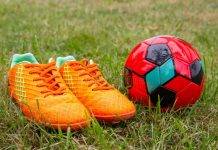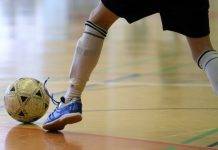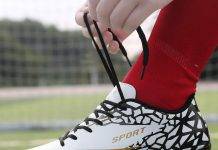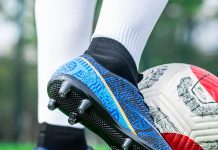Curious about the mysterious abbreviation “FG” you’ve noticed on soccer cleats? We’re here to shed some light on this intriguing acronym. So, what does FG mean in soccer cleats? Well, wonder no more! In this article, we’ll unravel the meaning behind FG and explore its significance in the world of soccer footwear. Prepare to uncover the secret behind this code and enhance your soccer knowledge in the process!
This image is property of i.ytimg.com.
Understanding Soccer Cleat Terminology
Soccer cleats come in various types and styles, each designed to provide optimal performance on different playing surfaces. As soccer enthusiasts, it’s important for us to understand the terminology associated with soccer cleats. This knowledge empowers us to make informed decisions when it comes to choosing the right cleats for our needs. In this article, we will delve into the meaning of FG cleats, explore their advantages and disadvantages, and also discuss alternative cleat options. So let’s jump right in and broaden our understanding of soccer cleat terminology!
Defining FG Cleats
FG stands for Firm Ground, making FG cleats perfect for playing on natural grass surfaces. These surfaces can range from freshly mowed and well-maintained fields to slightly worn-out and dry pitches. FG cleats are the most common type of soccer cleats and are widely used by players of all levels. They are designed to provide optimal traction and stability on firm ground surfaces, allowing players to maneuver with ease and perform at their best.
Different Types of Soccer Cleats
Before we delve deeper into FG cleats, let’s take a quick look at the other types of soccer cleats available in the market. Understanding the differences between these variations will help us make a more informed decision when selecting the right pair of cleats for our specific needs.
Review contents
SG – Soft Ground Cleats
SG cleats, also known as Soft Ground cleats, are designed for use on wet and muddy surfaces. They feature longer and detachable studs, which provide exceptional traction and prevent players from slipping on soft ground.
AG – Artificial Ground Cleats
Artificial ground, such as artificial turf or synthetic grass, requires a different type of cleat to maximize performance. AG cleats are specifically designed for use on these surfaces. They feature shorter and more numerous studs, allowing players to maintain stability and grip on artificial turf.
TF – Turf Cleats
Turf cleats, also known as TF cleats, are suitable for playing on turf surfaces. These surfaces are often found in indoor soccer arenas and are made of rubber or synthetic materials. TF cleats have shorter and denser studs, which provide excellent traction on artificial turf.
IN – Indoor Cleats
Indoor soccer is played on hard and flat surfaces, such as gymnasium floors or indoor turf. IN cleats are designed specifically for this type of indoor play. They typically feature a gum rubber outsole, which provides better grip and control on indoor surfaces.
Now that we have a basic understanding of the different types of soccer cleats, let’s delve deeper into the meaning of FG cleats and explore their advantages and disadvantages.
The Meaning of FG
When it comes to soccer cleats, FG stands for Firm Ground. This indicates that these cleats are specifically designed for playing on natural grass surfaces, which are considered firm grounds. Firm grounds are typically well-maintained grass fields that are neither extremely soft nor extremely hard. They provide a good balance between grip and stability, making them the most common playing surface for soccer matches and training sessions.
Firm Ground Surfaces
Firm ground surfaces are usually found in outdoor stadiums, parks, and soccer fields. These surfaces are carefully maintained to ensure an even and consistent playing field. They offer a natural feel and allow players to experience the true bounce and roll of the ball. FG cleats are designed to excel on these surfaces, providing players with the necessary grip and traction to make quick turns, accelerate, and stop abruptly without slipping.
Key Features of FG Cleats
FG cleats have several features that make them ideal for firm ground surfaces. Firstly, they have a configuration of molded studs or blades that provide optimal traction on natural grass. These studs are strategically placed to evenly distribute the player’s weight, preventing any unnecessary pressure points. Additionally, FG cleats often have a solid soleplate that offers stability and support throughout the game. The combination of these features allows players to confidently showcase their skills on firm ground surfaces.
This image is property of i.ytimg.com.
Advantages of FG Cleats
Now that we understand what FG cleats are and their suitability for firm ground surfaces let’s explore the advantages they offer to soccer players.
Versatility on Natural Grass
One of the biggest advantages of FG cleats is their versatility on natural grass surfaces. As the most common playing surface for soccer, having a pair of FG cleats ensures that you’re always prepared for a game or training session. Whether you’re playing on a perfectly manicured field or a slightly worn-out pitch, FG cleats provide the necessary traction and stability to perform at your best.
Ideal for Dry Conditions
Another advantage of FG cleats is their performance in dry conditions. As the name suggests, firm ground surfaces are often dry, especially during summer or in regions with limited rainfall. FG cleats are designed to excel in these conditions, allowing players to maintain their grip on the field. The configuration of the studs on FG cleats helps prevent slips and slides, ensuring that players can confidently and comfortably navigate the pitch.
Better Traction and Stability
FG cleats offer better traction and stability compared to other types of cleats on firm ground surfaces. The combination of the stud configuration and the solid soleplate provides a secure grip on the grass, helping players make quick turns, sudden stops, and explosive movements without losing their footing. This increased stability allows players to focus on their skills and gameplay, without worrying about slipping and getting injured.
Disadvantages of FG Cleats
While FG cleats have numerous advantages, it’s also essential to consider their potential limitations on certain surfaces. Let’s explore the disadvantages of FG cleats to gain a balanced understanding.
Limited Performance on Other Surfaces
One of the primary disadvantages of FG cleats is their limited performance on surfaces other than firm ground. While they excel on natural grass, they may not provide the same level of traction on wet or muddy surfaces. The shorter and non-detachable studs of FG cleats cannot penetrate the soft surface effectively, potentially reducing grip and stability. If you frequently play on wet or muddy grounds, it may be more beneficial to consider SG cleats instead.
Lack of Cushioning on Hard Ground
Firm ground surfaces can sometimes be hard and unforgiving, especially in dry climates or during summer months. FG cleats, with their rigid soleplates, may not provide adequate cushioning on such surfaces. Players with a preference for more cushioning and shock absorption may find FG cleats lacking in this regard. In such cases, it may be worth exploring cleats that have additional cushioning or support, such as hybrid models or those specifically designed for hard ground.
This image is property of i.ytimg.com.
Alternative Cleat Options
Understanding the different types of soccer cleats available allows us to explore alternative options that may better suit our playing needs. Let’s take a closer look at some of the popular alternatives to FG cleats.
SG – Soft Ground Cleats
As briefly mentioned earlier, SG cleats are specifically designed for wet and muddy surfaces. They feature longer and detachable studs that provide excellent traction on soft ground. If you frequently play on grounds with heavy rainfall or muddy conditions, SG cleats may be a better option for you than FG cleats.
AG – Artificial Ground Cleats
To maximize performance on artificial turf or synthetic grass, consider AG cleats. These cleats have shorter and more numerous studs compared to FG cleats, ensuring better grip and stability on these surfaces. AG cleats are a popular choice for those who play on artificial turf regularly.
TF – Turf Cleats
For indoor soccer on rubber or synthetic turf surfaces, TF cleats are the way to go. With shorter and denser studs, TF cleats provide the necessary traction and grip for fast-paced indoor play. They are designed to prevent slipping while allowing players to maneuver and change directions quickly.
IN – Indoor Cleats
Lastly, if you’re playing indoor soccer on hard and flat surfaces, such as gymnasium floors, consider IN cleats. These cleats are designed specifically for indoor play and feature a gum rubber outsole that provides excellent grip and control on these types of surfaces.
Choosing the Right Cleats for Your Needs
Choosing the right soccer cleats goes beyond understanding the different types and their suitability for various surfaces. Here are some important factors to consider when selecting the perfect pair of cleats for your needs.
Consider Playing Surface
The first factor to consider is the type of playing surface you’ll primarily be playing on. Determine whether you’ll be playing on firm ground, soft ground, artificial turf, or indoor surfaces. This will help you narrow down your options and choose cleats that offer optimal performance on your preferred playing surface.
Climate and Weather Conditions
Next, consider the climate and weather conditions of the region where you’ll be playing. If you frequently play in wet or muddy conditions, cleats with detachable studs or a more aggressive stud configuration, such as SG cleats, may be beneficial. On the other hand, if you mostly play in dry conditions, FG cleats will provide the necessary traction and stability.
Player Position and Playing Style
Another important factor to consider is your player position and playing style. Different positions require different levels of agility, stability, and control. For example, a forward may prefer cleats that offer excellent grip for quick sprints and explosive movements, while a defender may prioritize stability and durability. Understanding your playing style and position will help you choose cleats that cater to your specific needs.
This image is property of www.metroleague.org.
FAQs about FG Cleats
To wrap up our comprehensive guide to FG cleats, let’s address some frequently asked questions that soccer players often have regarding this popular type of cleat.
Why are FG cleats the most common?
FG cleats are the most common type of soccer cleats mainly due to their versatility and performance on firm ground surfaces. Since firm ground is the most prevalent playing surface in soccer, FG cleats provide the necessary traction, stability, and grip for players to perform at their best. Their suitability for a wide range of grass conditions and dry weather also contributes to their widespread use.
Can I use FG cleats on artificial turf?
While FG cleats may provide some level of traction on artificial turf, they are not specifically designed for this surface. The shorter studs on FG cleats may not penetrate the artificial turf effectively, potentially leading to reduced grip and stability. If you frequently play on artificial turf, it’s recommended to invest in AG cleats, which are specifically designed for this type of surface.
Are FG cleats suitable for wide feet?
FG cleats come in various sizes and widths to accommodate different foot shapes. Many brands offer cleats specifically designed for wide feet, ensuring a comfortable and secure fit. However, it’s always important to try on cleats before purchasing them to ensure the best fit for your individual needs.
By understanding the meaning of FG cleats, considering their advantages and disadvantages, exploring alternative cleat options, and considering important factors when choosing cleats, we can make informed decisions and select the perfect pair of soccer cleats that suit our playing style and needs. So lace up your cleats, step onto the field with confidence, and enjoy the beautiful game of soccer!









































